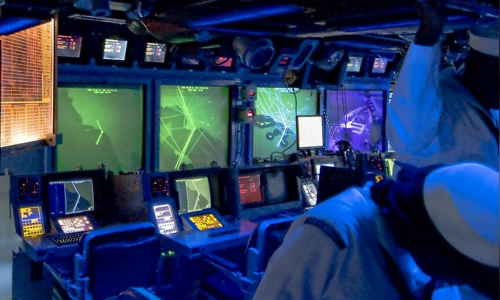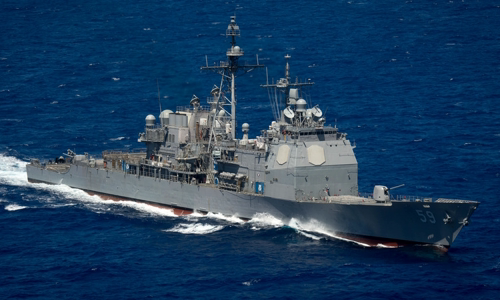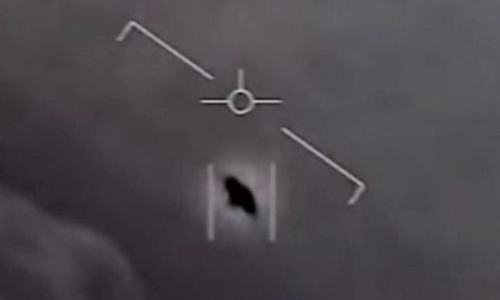The radar expert on the cruiser Princeton thought the system had failed before he realized he was catching UFOs in the sky off the US in 2004.
The US Navy in September acknowledged for the first time the existence of unidentified flying objects (UFOs) in videos filmed by F / A-18E / F fighter pilots in 2004 and 2015. published in late 2017 shows strange, oblong, very fast moving objects detected by sensors on fighters.

CIC Center of USS Princeton Photo: US Navy
A group of former US Navy soldiers on November 13 decided to speak out about a UFO encounter during a training mission with the USS Nimitz aircraft carrier combat group in waters about 160 km from California, USA in November 2004. .
These soldiers are members of the USS Princeton crew, the cruiser has been equipped with new systems such as the radar alert AN / SPY-1B, joined a combat group deployed for several months to test the weapon. and eliminate potential technical errors, according to Corporal Gary Voorhis, then USS Princeton radar expert.
Several onboard radar crews said they repeatedly detected "ghost signals" and "noises" on the display when attending the training. This is of concern to Voorhis, the only technician in charge of the Joint Combat System (CEC) and the Aegis shield on USS Princeton.
Voorhis requires that the airspace management system be turned off and readjusted to eliminate error signals, in case AN / SPY-1B radar malfunctions. However, this adjustment does not make the "ghost signal" disappear but also become stronger.
"After the calibration and reboot of the system were completed, the actual feedback signals were sharper and clearer. Sometimes they appeared at an altitude of 18,000-24,000 m, at other times at an altitude of about 10,000 m. with a speed of nearly 200 km / h. Their radar cross section is unlike any other aircraft and completely unresponsive to the enemy identification signal - I (IFF) ", Voorhis added.
Kevin Day, an airspace surveillance specialist around USS Princeton, also detected unusual signals on the radar during his days working at the Battle Center Information Center (CIC) of the US cruiser. "They are very strange because they often appear in groups of 5-10 objects and move close distances," Day recalls.

Princeton cruiser maneuvers on the Pacific in 2016 Photo: US Navy.
Voorhis gradually believed that this was not a radar incident and sought to identify the origin of foreign objects. The sergeant located the feedback signal on the AN / SPY-1B radar, then used powerful binoculars to identify them with the naked eye. The object was too far away, but Voorhis still saw something moving at high speed.
"I couldn't see the details. They seemed to hover in place and then suddenly rushed to another position and continued to stand still. They emitted fluorescent light at night and were easier to see than you. days, "Voorhis recalls.
After nearly a week of follow-up, Day convinced his superior to investigate two F / A-18 fighters approaching and investigating foreign objects. The US pilot identified the target with the naked eye from a distance of nearly 1.5 km, describing it as "a long, white, smooth egg-shaped object with no sharp edges".
The American fighters could not get close to the UFO and were forced to return to the aircraft carrier USS Nimitz shortly thereafter.
The second tracking effort led to a video revealed late 2017, showing a capsule-shaped object on the infrared-tracking system of the F / A-18E / F Super Hornet fighter. The Pentagon insists the video is hosted on internal databases and has never been allowed to publish it before.
15 years after the encounter, former USS Princeton crew members still do not understand what happened during and after the training.

UFO appears on the infrared sensor of Super Hornet fighter Photo: US Navy
Shortly after the F / A-18E / Fs returned to land, two officers appeared on Princeton to collect radar tracking data and Voorhis was required to hand them over immediately. Every storage device on the cruiser is wiped clean. "They asked me to erase everything, including unused tapes," Voorhis recalls.
"A Black Hawk helicopter then landed on our battleship and transferred all information from the top secret data room. We were shocked, but the unwritten rule was not to mention it because we didn't want him. enjoy his career, "said an unnamed officer on USS Princeton.
This led many to think of an attempt to cover up the existence of UFOs and avoid making the information public. Lieutenant Colonel David Fravor, pilot who approached the object in 2004, admitted that sensor data on the F / A-18E also disappeared strangely, but assumed that they could be lost or accidentally overwritten. .
"I think Lieutenant Colonel Fravor's opinion is the most plausible explanation. However, many crew members also have access to those tapes. This leaves the possibility of someone deliberately carrying them. ", said Vincent Aiello, a former US aircraft fighter pilot.
There are still many disagreements among former US Navy veterans about the 2004 incident, but they all think that it is not simply a radar fault. "This is a lot more mysterious than what you saw in the 2017 leaked video," said Corporal Jason Turner, a former USS Princeton crew member.



 TraciMoore
TraciMoore







